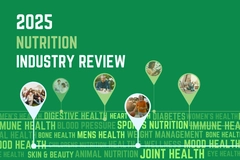
- Industry news
Industry news
- Category news
- Reports
- Key trends
- Multimedia
Multimedia
- Journal
- Events
- Suppliers
Suppliers
- Home
- Industry news
Industry news
- Category news
- Reports
- Key trends
- Multimedia
Multimedia
- Events
- Suppliers
Suppliers
Sports performance boosters diversify into new targeted health outcomes and formats

21 Jul 2022 --- The industry for sports products is expanding beyond conventionally targeting mostly male athletes, toward women and everyday active consumers. With consumers exhibiting an expanded interest in broader health outcomes, nutrients other than proteins for muscle building are in the spotlight, with a large focus on branded ingredients.
NutritionInsight speaks with Solagia Algatech, Pharmactive and PLT Health on the latest trends in sports performance boosters.
“A new generation of athletes and active consumers wants more than muscle-building supplements and is looking for products that will enhance their physical and mental well-being,” says Liat Shemesh, marketing manager at Solagia Algatech.
“Therefore, we see more and more new products that offer a holistic solution with various active health claims for holistic well-being targeting energy, mood, immunity and even beauty,” she comments.
“This is one of the most exciting times I can remember in my nearly 20 years of working in the sports/active nutrition field,” says Steve Fink, vice president of marketing at PLT Health.
“New benefits seeked by consumers include cognitive/focus support, joint and muscle recovery, weight management, original approaches to energy profiles and more. The flip side of this trend is that these formulations are gaining interest in a more mainstream active audience who want all these benefits. The sports/active nutrition industry is helping to create the future of the mainstream market,” adds Fink.
Trending ingredients Demand for quality ingredients has increased and consumers seek transparency in products.
Demand for quality ingredients has increased and consumers seek transparency in products.
Fink says that branded ingredients are trending, as the top-selling products on marketplaces such as Amazon contain branded ingredients. As consumer awareness has increased, there is now a rising perception that non-branded ingredients may lack transparency about what they contain and where they come from.
“Weight management-type ingredients are also becoming more popular in sports/active nutrition products. Every major company has formulations that include calorie-burning or weight loss ingredients. On this latter point, it is important that weight management occurs without losing lean muscle mass,” Fink adds.
“Protein-based products such as protein powders, protein energy bars and protein ready-to-drink beverages contribute approximately 87% of the value of the sports nutrition market. On the other hand, non-protein products such as pre-workout supplements account for 13%,” says Cristian Conde, marketing associate at Pharmactive.
“Vitamin supplements have always accounted for a large part of the market, but after the pandemic, their consumption has increased greatly. Perhaps the general population, especially those who regularly practice sports, are more aware of their nutritional requirements.”
Supplements for deficiencies Protein powder is said to still have the largest market share although demand and curiosity expands for alternative formats.
Protein powder is said to still have the largest market share although demand and curiosity expands for alternative formats.
Conde explains that many of the diets or eating patterns consumers follow are deficient in some micronutrients, which leads them to consume these supplements.
“It should be noted that consuming protein powder continues to lead the sports nutrition market, with a percentage close to 80% of the products in this sector. The consumption of proteins of vegetable origin is increasing, and, little by little, they are stealing the limelight from the traditional milk whey,” says Conde.
“There has been a noticeable increase in the claims made by sports nutrition products regarding immune system health, brain health, cognitive health, digestive health and bone health,” says Shemesh.
“Magnesium Glycerophosphate, for instance, is a mixture of magnesium, glycerol and phosphorus. All three compounds are essential for optimal muscle function. Magnesium also plays a key role in the immune response including antibody synthesis and macrophage response.”
Finally, Shemesh highlights Vitamin B6 as a popular ingredient involved in many essential functions, including muscle building and energy provided during exercise. In addition, it helps improve the function of the entire immune system.
Novel delivery systems
Industry members disagree on the directions of formats. Conde explains that “it cannot be said that there has been a great change in recent years since powder formats continue to lead the market.”
“I am not only referring to proteins but also to pre-workouts, which with such a high recommended daily dose have no place in encapsulated forms,” he notes. “In addition, much of the innovation in this sector has focused on improving the flavors and appearance of these powdered products once rehydrated.”
“Consumers want products that are convenient, easy to prepare and taste good. We can see more jelly drinks, nutritional shots and enriched water,” Shemesh adds.
Fink notes that there are “dramatic increases in alternative delivery systems – particularly in the beverage arena across many health and wellness categories. We often find that high-performing, clinically studied functional ingredients have organoleptic issues. Viscosity, solubility and taste are chief among these.”
“This is particularly true of many botanical extracts – which often find themselves relegated to pill-form delivery. In recent years, PLT has worked with ingredient innovators worldwide to introduce water dispersible/soluble and neutral tasting ingredients. These work in beverages and other products like gummies, stick packs, powders and more.”
“On the other hand, protein powder consumption continues to lead the sports nutrition market, with a percentage close to 80% of the products in this sector. The consumption of proteins of vegetable origin is increasing, and, little by little, they are stealing the limelight from the traditional milk whey,” Conde adds.
Target group changed The sports category has diversified from athlete focus to suit everyone searching for an active life.
The sports category has diversified from athlete focus to suit everyone searching for an active life.
Conde highlights that the world of sports nutrition and supplementation was focused on men as the leading consumer, and that this has changed. “Sports supplements focused on women are becoming increasingly common and undoubtedly represent one of the niches growing every year.”
“As in other sectors, the application of new, greener and eco-friendly production processes is being sought, trying as far as possible to achieve a carbon footprint close to 0. The opportunities are endless as consumers increasingly value good practices regarding environmental responsibility,” he adds.
Fink adds that there are more reformulations and launches of the traditional types of sports products like pre-workouts compared to a year ago. “But we’re also seeing products targeting everyday active people. Muscle and strength benefits are becoming more mainstream with each passing month.”
“During the past two years, more and more consumers have been consuming better-for-you products, making sports nutrition products no longer a niche market designed only for professional athletes but now part of the wider world of active nutrition. Sports nutrition is now a category for anyone who enjoys being active and wants to perform at their best – whether in the gym, on the court, or even at home,” Shemesh notes.
She highlights that consumers are increasingly reading labels and looking for premium quality ingredients they recognize and branded ingredients. “They want science-based, natural, manufactured in an environmentally friendly manner, GMO-free and vegan ingredients.”
“We are extremely optimistic about the active/sports category and believe it will continue strong growth. It might grow differently than it has in the past, with products requiring differentiated features and benefits, better and more believable clinical science, and experiential – or fast-acting – results,” Fink concludes.
By Beatrice Wihlander











